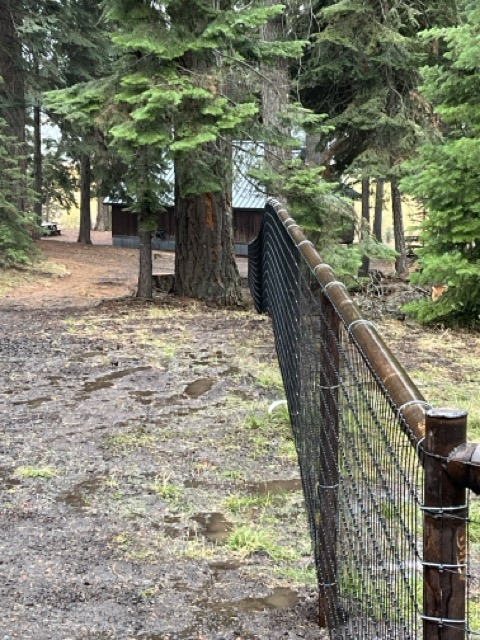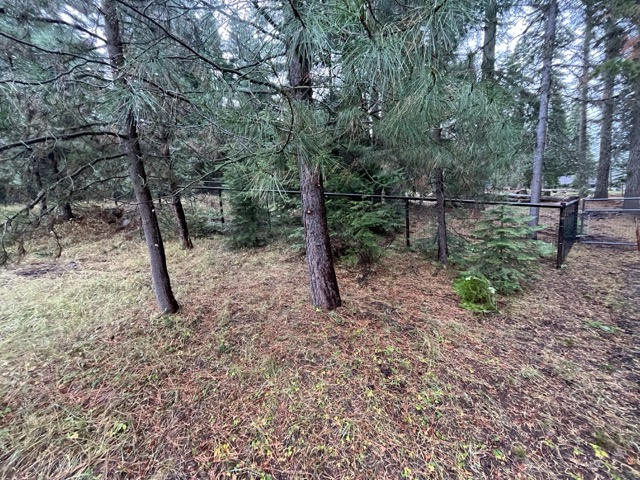Fencing for Predator Control: How to Protect Your Livestock from Wildlife Threats
A Blog by Cascade Fencing
Keep Your Livestock Safe
Livestock protection is one of the biggest concerns for farmers and ranchers. Predators such as coyotes, foxes, wolves, and bears pose a serious threat to animals, and without proper fencing, farms can suffer major losses. Whether you are raising cattle, sheep, goats, or poultry, ensuring that your fence can effectively keep predators out is essential.
A well-designed fence is not just a physical barrier—it’s a deterrent that prevents predators from even attempting to access your livestock. Choosing the right fencing solution, combined with additional protective measures, can significantly reduce predation risks and give you peace of mind.
In this guide, we will explore the best fencing options for predator control, effective reinforcement techniques, and additional deterrents to help keep your farm safe year-round.

Understanding the Predator Threats on Your Farm
Different predators use different strategies to attack livestock. Some climb over fences, others dig under them, and some use brute force to break through. Knowing which predators are common in your area will help determine the best fencing solution for your farm.
Common Predators and Their Attack Methods
- Coyotes – One of the most common predators, coyotes dig under and jump over fences. They primarily target small livestock such as sheep, goats, and poultry.
- Foxes – Foxes are small and agile, often squeezing through gaps in fences or digging under them to reach poultry and newborn livestock.
- Wolves – Wolves are powerful predators capable of jumping high fences or pushing through weak spots. They often attack larger animals such as cattle and horses.
- Bears – Strong and determined, bears can break through weak fences or climb over them to reach livestock. They are particularly dangerous for sheep, goats, and calves.
- Stray Dogs – Domestic dogs can chase and injure livestock, often causing stress-related illnesses or fatal wounds. They may also push through loose fencing.

Each of these predators requires different fencing solutions to prevent them from reaching your animals.
Best Fencing Options for Predator Control
The type of fence you choose should be strong enough to withstand predator attempts while also being practical for your farm’s specific needs. Below are the most effective fencing options for keeping predators out.
Electric Fencing
Electric fencing is one of the best deterrents for predators. It delivers a mild but effective shock, teaching predators to stay away after a single encounter.
Advantages:
✔ Works as both a physical and psychological barrier.
✔ Can be used alone or alongside other fencing options.
✔ Minimal maintenance compared to traditional fencing.
Best Practices:
- Use at least five strands of electric wire, with the lowest strand no more than 6 inches off the ground to prevent digging.
- Maintain a minimum of 5,000 volts for an effective deterrent.
- Regularly trim vegetation near the fence to prevent grounding issues.
Woven Wire Fencing
Woven wire fencing is strong and effective, preventing predators from squeezing through or climbing over.
Advantages:
✔ Provides a solid physical barrier.
✔ Suitable for various livestock types.
✔ Long-lasting and requires minimal maintenance.
Best Practices:
- Use fencing with small mesh spacing (under 4 inches) to prevent foxes or coyotes from squeezing through.
- Extend the fence at least 6 inches underground to prevent digging.
- Install an electric wire on top to stop climbing predators.
High-Tensile Wire Fencing
High-tensile fencing is cost-effective and durable, making it ideal for large farms. It can be electrified for added security.
Advantages:
✔ Strong and flexible, preventing breakage.
✔ Suitable for large grazing areas.
✔ Can be combined with electric fencing.
Best Practices:
- Use at least 8 strands of wire, with closer spacing near the bottom to block smaller predators.
- Ensure proper tensioning to avoid weak spots.
- Pair with electric fencing for maximum effectiveness.
Chain Link Fencing
Chain link fencing is commonly used for poultry and small animal enclosures where predators are a significant concern.
Advantages:
✔ Resistant to breaking and climbing.
✔ Ideal for securing specific areas such as barns or coops.
✔ Can be reinforced with barbed wire or electric fencing.
Best Practices:
- Ensure a minimum height of 6 feet to prevent jumping.
- Bury the bottom at least 12 inches underground to stop digging.
- Angle the top outward at 45 degrees to prevent climbing.
Additional Predator Deterrents
Even the best fencing can benefit from extra security measures. Adding deterrents to your farm can further discourage predators from attempting to breach your fence.
Livestock Guardian Animals
Many farmers use guardian animals such as:
- Livestock Guardian Dogs (LGDs) – Trained to protect livestock and chase away predators.
- Donkeys and Llamas – Naturally aggressive toward coyotes and other predators, making them great deterrents.
Motion-Activated Lights and Sounds
Predators prefer to attack under cover of darkness. Motion-activated floodlights and noise deterrents can scare them away before they get close to your livestock.
Scent and Noise-Based Deterrents
- Predator Urine – Spraying coyote or wolf urine around fence lines can deter smaller predators.
- Ultrasonic Sound Devices – Emit high-frequency sounds that are uncomfortable for predators but harmless to livestock.
Routine Fence Inspections
- Walk along the fence line weekly to check for weak spots.
- Keep electric fences charged and vegetation trimmed.
- Secure gates with predator-proof latches.
Choosing the Right Fence for Your Farm
With multiple fencing options available, selecting the right one depends on the predators in your area, your budget, and the livestock you’re protecting.
Fence Type | Best For | Primary Predator Deterrent |
Electric Fencing | All livestock & general predator control | Shock deterrent |
Woven Wire Fencing | Sheep, goats, poultry | Strong physical barrier |
High-Tensile Wire | Large pastures, cattle | Strong tension, electric option |
Chain Link Fencing | Poultry, small enclosures | Climbing and digging deterrent |
For many farms, a combination of fencing types is the best approach. For example, a woven wire fence with an electric top wire provides multi-layered protection against various predators.
The Role of Multi-Layered Fencing in Predator Control
No single fence can provide complete protection against all predators, which is why multi-layered fencing is one of the best strategies for farms dealing with a variety of threats. By combining different fencing types, farmers can create a highly effective barrier that addresses multiple predator behaviors, such as climbing, digging, or jumping.
How Multi-Layered Fencing Works
A layered fencing system typically consists of two or more barriers that work together to prevent predators from reaching livestock. Some common combinations include:
- Woven Wire + Electric Fencing – The woven wire acts as a strong physical barrier, while an electric wire positioned at the top and bottom deters predators from climbing or digging.
- High-Tensile Wire + Barbed Wire – High-tensile fencing provides durability, while a barbed wire top discourages large predators such as wolves and bears.
- Chain Link + Motion-Activated Lights – Chain link fencing secures small enclosures, while motion-activated deterrents startle predators before they attempt an attack.
Benefits of Multi-Layered Fencing
✔ Reduces Predator Persistence – If a predator breaches one barrier, the second layer prevents them from reaching livestock.
✔ Deters Multiple Predator Types – Electric deterrents work against climbing predators, while underground barriers stop digging animals.
✔ Adds Extra Security to Weak Points – Multi-layered fences reinforce entry points, corners, and high-risk areas.
Best Practices for Installing Multi-Layered Fencing
- Keep the bottom wire close to the ground (6 inches or less) to stop digging predators.
- Use angled extensions at the top of the fence to prevent climbing.
- Maintain a minimum fence height of 6 feet to deter jumping predators.
- Conduct regular inspections to ensure all layers remain functional and free of damage.
Multi-layered fencing provides one of the most reliable ways to protect livestock from persistent predator attacks. By reinforcing vulnerable areas and using different materials, farmers can significantly reduce losses and improve farm security.
How Climate and Terrain Impact Predator-Proof Fencing
The effectiveness of predator-proof fencing is influenced by the climate and terrain of your farm. Harsh weather conditions and difficult landscapes can weaken fences, create vulnerabilities, and make installation more challenging.
Fencing Challenges by Climate
Cold Climates & Heavy Snow
- Risk: Snow accumulation can weigh down fences, causing sagging or collapse.
- Solution: Use high-tensile wire to maintain tension, and install tall fences (at least 6 feet) to stay effective after snowfall.
Wet & Humid Conditions
- Risk: Moisture leads to wood rot, rusting metal, and weakened fence posts.
- Solution: Choose treated cedar or pressure-treated wood, and apply rust-resistant coatings on metal fences.
Hot & Dry Climates
- Risk: Extreme heat causes wood to warp and metal to expand, creating gaps in fencing.
- Solution: Use UV-resistant sealants on wood and check tension in wire fences regularly to adjust for temperature changes.
Fencing Challenges by Terrain
Hilly or Uneven Land
- Risk: Uneven terrain makes it easier for predators to find gaps under the fence.
- Solution: Use welded wire or woven fencing, and adjust post heights to accommodate changes in elevation.
Rocky Soil
- Risk: Difficult to dig deep post holes for secure fencing.
- Solution: Use driven steel posts or cement footings to anchor fences in rocky ground.
By considering climate and terrain challenges when installing fencing, farmers can create a secure and long-lasting predator barrier that withstands the elements and protects livestock all year round.
Investing in Predator-Proof Fencing
Protecting your livestock from predators is essential for the success of your farm. A well-designed fence can prevent attacks, reduce stress on your animals, and provide long-term peace of mind.
By choosing the right fencing materials, reinforcing vulnerable areas, and incorporating deterrents like guardian animals or motion-activated lights, you can create a secure environment for your farm.
At Cascade Fencing, we specialize in agricultural fencing in Prineville, OR, offering expert installation and durable fencing solutions tailored to your specific needs. Whether you need electric fencing, woven wire, or chain link fencing, our team is here to help. Contact us today for a consultation and take the next step in securing your farm.


